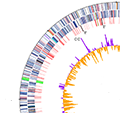Abstract
Background: Xanthomonas oryzae pv. oryzae causes bacterial blight of rice (Oryza sativa L.), a major disease that constrains production of this staple crop in many parts of the world. We report here on the complete genome sequence of strain PXO99A and its comparison to two previously sequenced strains, KACC10331 and MAFF311018, which are highly similar to one another.
Results: The PXO99A genome is a single circular chromosome of 5,240,075 bp, considerably longer than the genomes of the other strains (4,941,439 bp and 4,940,217 bp, respectively), and it contains 5083 protein-coding genes, including 87 not found in KACC10331 or MAFF311018. PXO99A contains a greater number of virulence-associated transcription activator-like effector genes and has at least ten major chromosomal rearrangements relative to KACC10331 and MAFF311018. PXO99A contains numerous copies of diverse insertion sequence elements, members of which are associated with 7 out of 10 of the major rearrangements. A rapidly-evolving CRISPR (clustered regularly interspersed short palindromic repeats) region contains evidence of dozens of phage infections unique to the PXO99A lineage. PXO99A also contains a unique, near-perfect tandem repeat of 212 kilobases close to the replication terminus.
Conclusion: Our results provide striking evidence of genome plasticity and rapid evolution within Xanthomonas oryzae pv. oryzae. The comparisons point to sources of genomic variation and candidates for strain-specific adaptations of this pathogen that help to explain the extraordinary diversity of Xanthomonas oryzae pv. oryzae genotypes and races that have been isolated from around the world.
